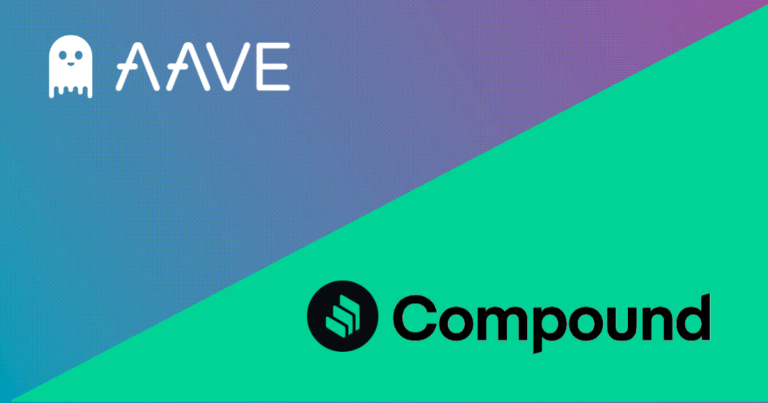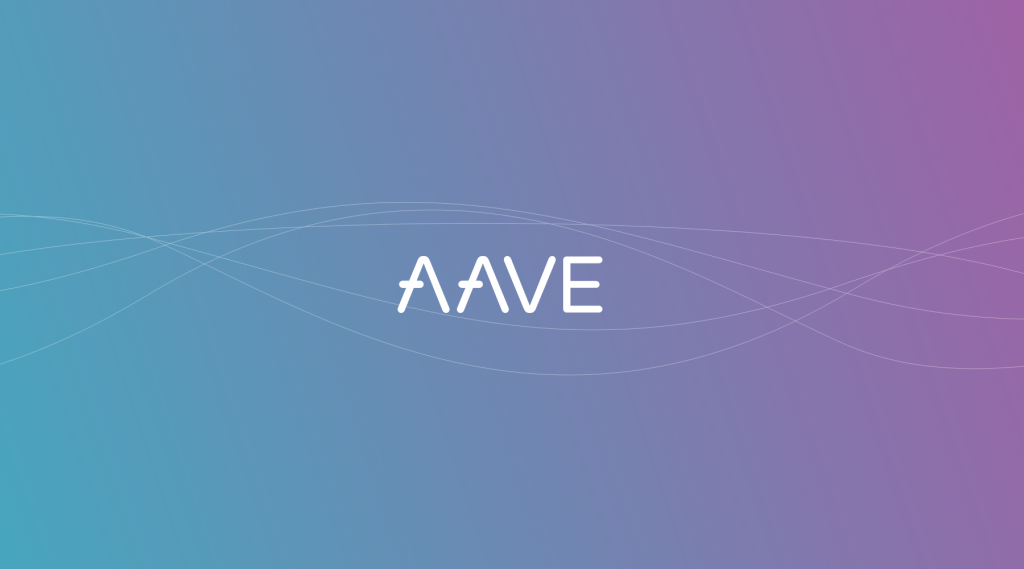The DeFi area replicates decentralized financial applications on the blockchain. Alongside the trading of various tokens, over-collateralized lending/borrowing has established itself as a leading force. A comparison of the two largest protocols: Compound Finance and Aave.
Aave and Compound are two of DeFi’s stalwarts: the two largest lending and borrowing protocols on Ethereum, each with a total value locked (TVL) over ten times larger than the third largest protocol. Both protocols have functioned nearly flawlessly this year while a growing number of centralized entities have been failing in often spectacular fashion. Aave has accumulated just $2.17mn of bad debt (most of which was generated in a recent, likely unprofitable exploit) relative to its $3.2bn TVL, while Compound has just $65,000 bad debt to its $1.5bn TVL.
They are not flashy, and thus do not receive much attention relative to their importance to DeFi. But, with both ready to make the transition to their V3s, and with Kaiko’s new lending and borrowing data, now is an ideal time to reflect on how the two have performed over the past year.
Amount of unique users
Throughout the first three months of the year, the number of unique wallets that interacted with each protocol was just about even. This trend began to shift in April, but was made most apparent in May, with Aave V2 registering 15,000 unique users compared to just over 4,750 on Compound.
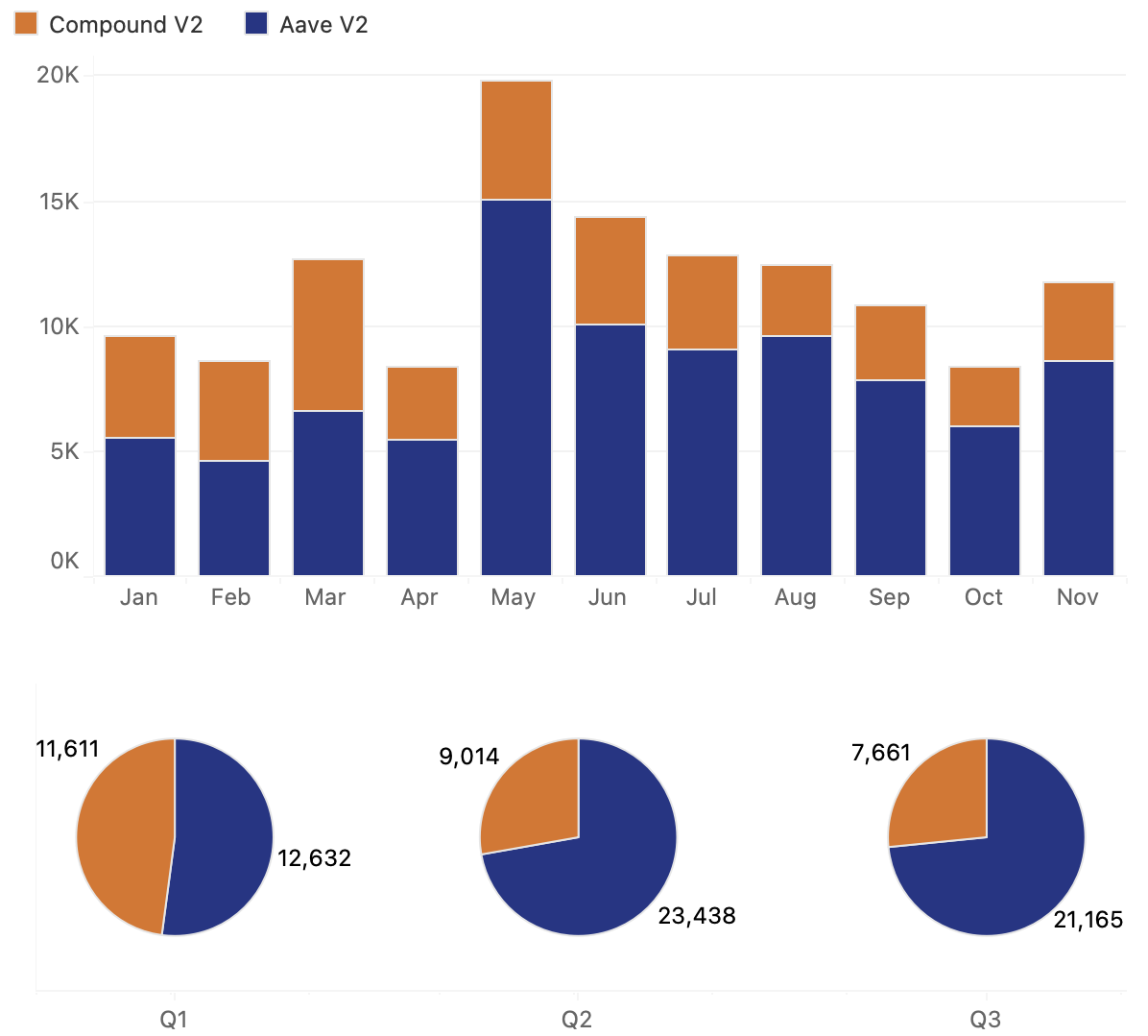
Over the course of Q2, Aave had more than 2.5 times more unique users than Compound. This again held in Q3, though Aave lost more than 2,000 users compared to about 1,400 fewer on Compound. These figures are notable for two reasons. First, because the number of users is still small; in their best month, Aave and Compound could fit all their users in one of Texas’s larger high school football stadiums and that's assuming that one user equals just one wallet address. Second and more importantly, the number of Aave active users grew after Terra’s collapse. This provides evidence to support the narrative that DeFi has proven itself more trustworthy than centralized entities this year.
Aave ahead in terms of deposit volume
Aave’s resilience is further reflected in a chart of monthly deposits (note that this is gross deposits, so if someone deposited 1 ETH at $3,500, withdrew and then deposited 1 ETH at $2,000, that would show as $5,500 of deposits). At the beginning of the year, Compound had about half of the deposits of Aave. Last month, Aave had over six times the deposits of Compound.
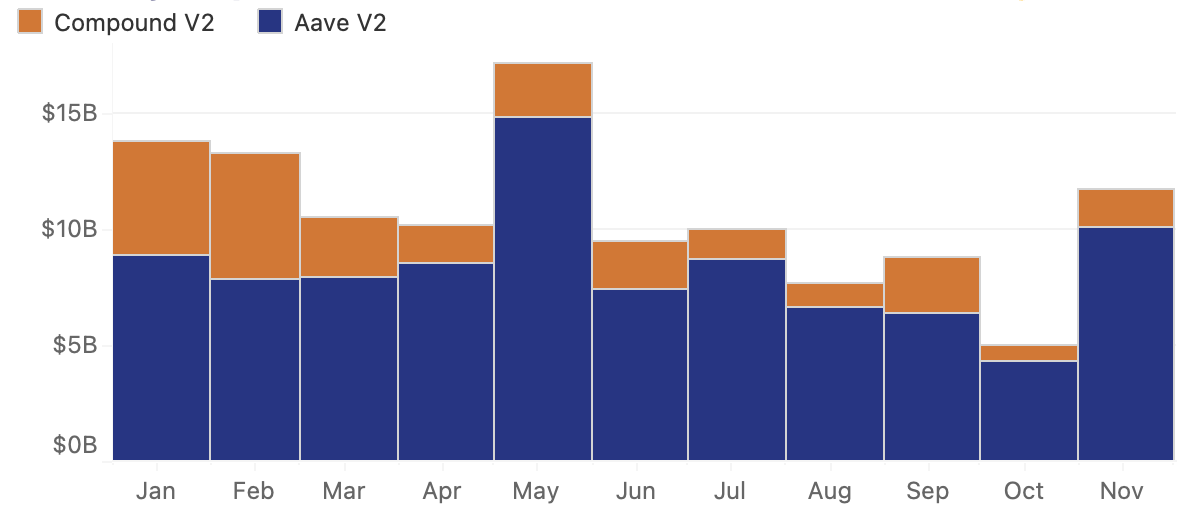
But, this is more of a story of Aave’s resilience rather than Compound’s failure. Despite the price of many crypto assets falling 70-90% since the beginning of the year, deposits on Aave have been remarkably stable, with November beating out January.
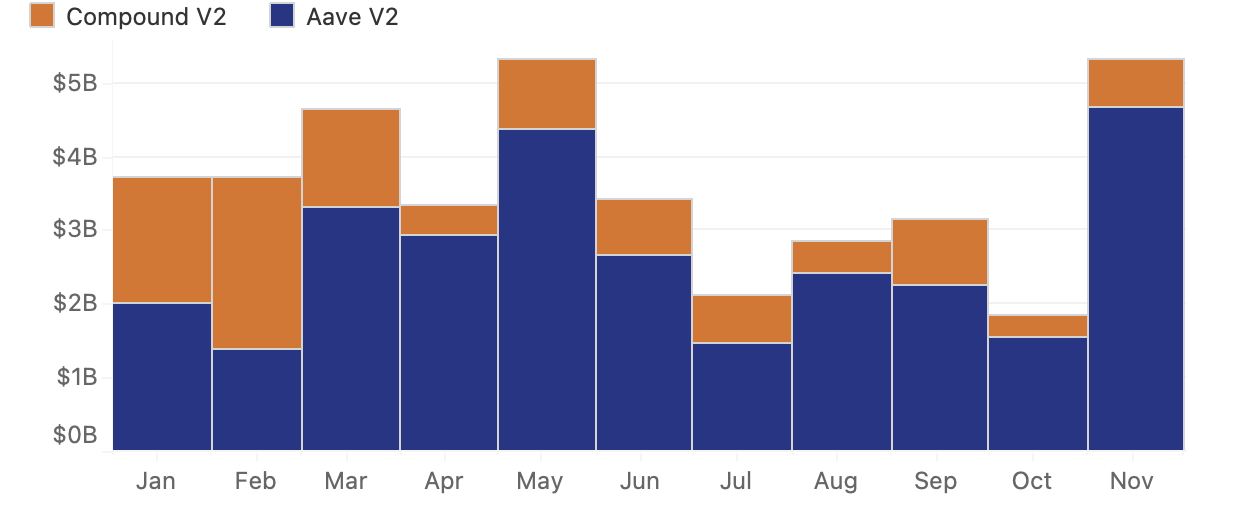
Moving to borrows (again with the same methodology as deposits), it’s fair to say that volatility and negative market events have been a boon for Aave’s usage. Meanwhile, Compound has struggled to match the borrows it hit in the first two months of the year.
Stablecoin dominance shows differences
Our data allows us to further break down these volumes to see where the differences lie between the two protocols. Beginning with Aave, the below chart shows that ETH and USDC represent over 75% of deposits and are normally the majority of withdrawals. There are many insights to be gleaned from these two charts, but for the sake of brevity we'll add just two more:
- USDT hit an ATH share of borrows in November as a result of attempts to short the token
- Staked Ether (stETH) represented nearly 60% of Aave deposits in July but is not available on Compound
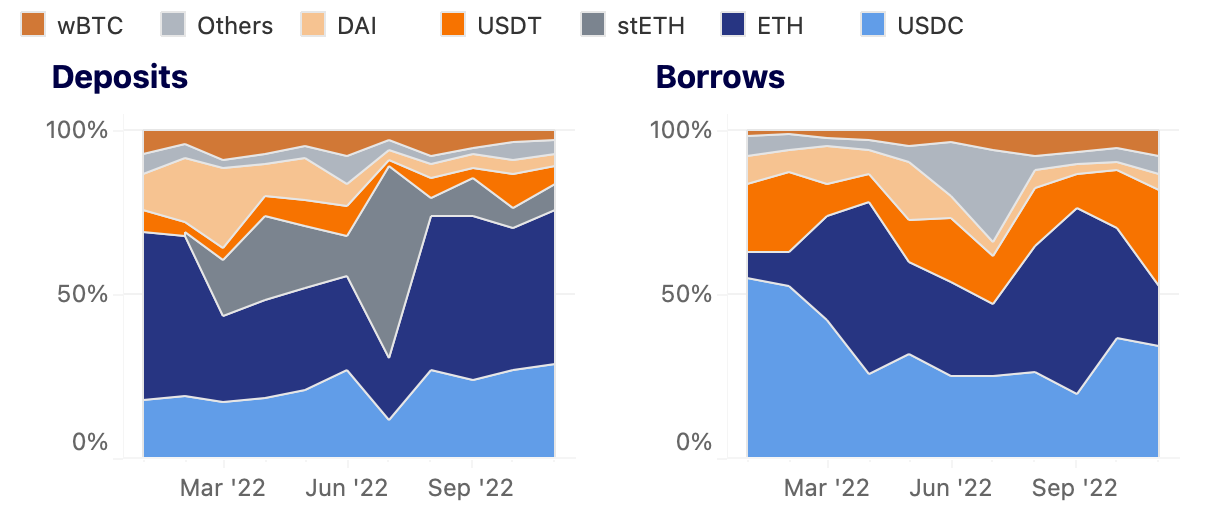
Moving on to Compound, it is instantly clear how different these two protocols are, despite outer appearances. USDC and ETH are about half of deposits, while DAI frequently exceeds 30%. This is even more pronounced for borrows, where USDC has held less than 20% share the past three months and ETH has been under 4% for the past two months.
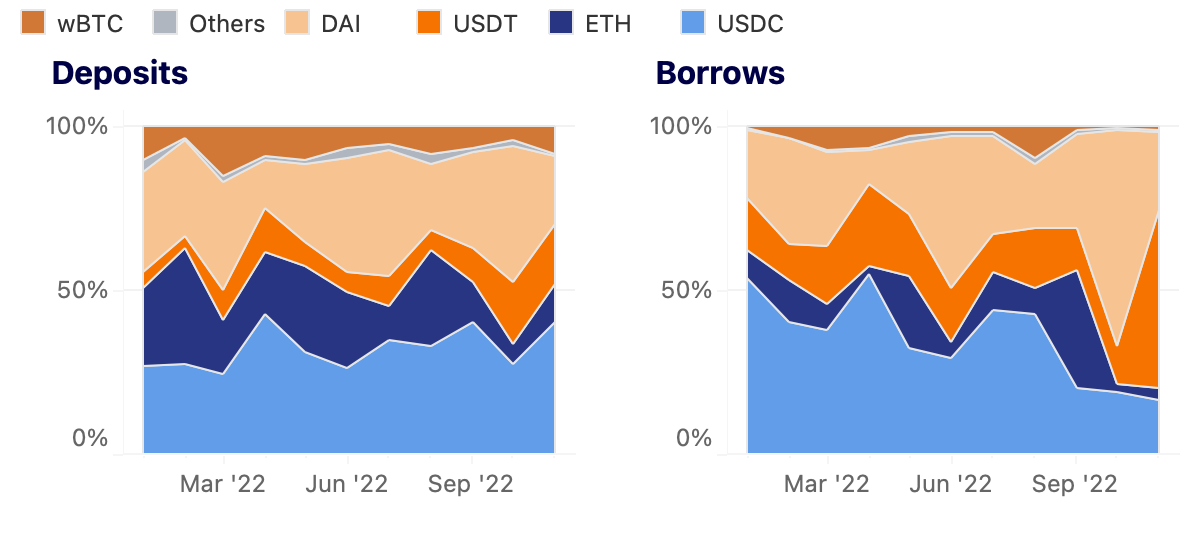
There is one clear and important similarity between the two: the "Others" category (which includes smaller stablecoins like TUSD and LUSD and tokens like UNI and SUSHI) is quite small for both. Both protocols have taken measures in recent months to prevent exploits and have thus frozen many of the smaller and less liquid tokens.
Similar interest rates on Aave and Compound
Rates across these protocols are similar for the most liquid and popular assets. As a reminder, the supply rate is the annual returns someone earns when depositing each asset into a protocol. Charted below are DAI and USDC supply rates.
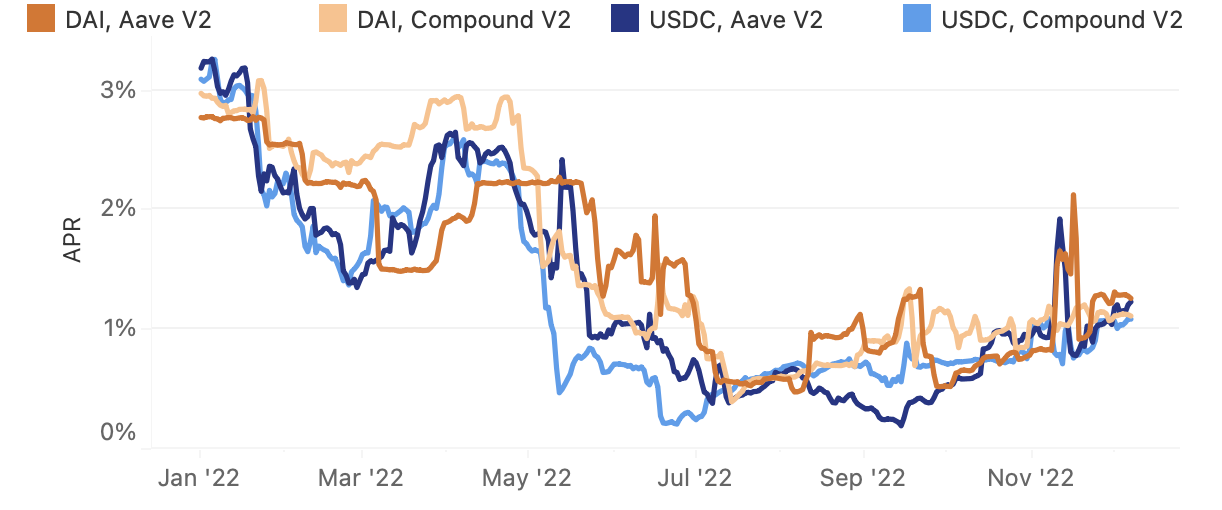
Rates for each stablecoin have generally tracked each other across platforms and have become tighter over the course of the year. However, it is important to note that these rates do not include the COMP (Compound's governance token) incentive for supplying DAI and USDC, which is 0.84% and 0.59%, respectively. There is a greater deviation in rates in less liquid assets, such as those included below.

Governance tokens
Both COMP and AAVE are governance tokens whose main purpose is to steer the course of the respective protocol. But, as has become increasingly obvious by the performance of DeFi governance tokens, and as elucidated by Ethereum co-founder Vitalik Buterin, this purpose alone does not inspire faith that the tokens' price will go up.
As a regular individual, "pay $500 to get a 0.0001% chance to influence the outcome of some votes" is just not a good trade. The only people for whom it is a good trade are multimillionaires and hedge funds (including attackers).
— vitalik.eth (@VitalikButerin) November 29, 2022
But COMP and AAVE also serve other purposes. COMP is used as an incentive (or subsidy, depending on your perspective) for lenders and borrowers. As mentioned above, 1,234 COMP is distributed as an incentive daily to both lenders and borrowers in the most popular markets on Compound. Meanwhile, Aave uses its token to encourage users to stake in its Safety Module and distributes 1,100 AAVE per day. At current prices, Aave is emitting about $67k per day and Compound $48k per day for these incentives.
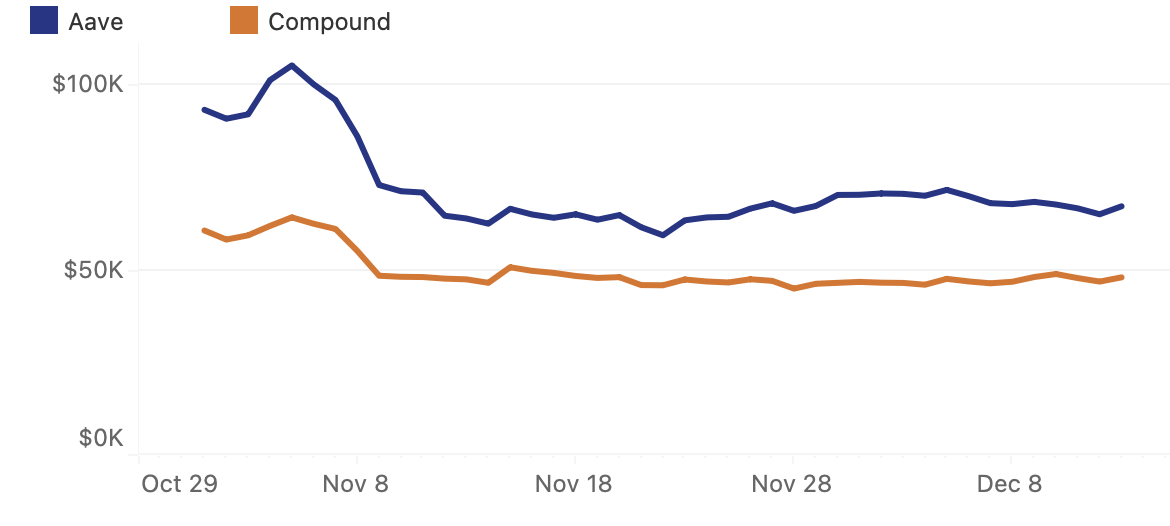
Both uses are potentially problematic. It is clear, especially with rates much lower than they were to start the year, that Compound’s COMP incentive is influencing behavior, particularly making DAI more attractive to lend and borrow. But it’s unclear whether these emissions are creating sticky users or benefiting the long-term health of the protocol.
Meanwhile, Aave’s Safety Module is intended to protect the protocol in the event of a shortfall event, whether caused by smart contract, oracle, or liquidation failures. In this event, up to 30% of the Safety Module can be sold off and in extreme cases AAVE can be minted to cover the deficit. Aave’s documents point to Uniswap as the market that would be used to swap AAVE for whichever asset, though Uniswap V3 only holds $3.39mn in AAVE liquidity across all pools (charted below) and close to $80mn in the AAVE/WETH Balancer pool, though 80% of this is AAVE.

Aave’s Safety Module is $227mn, meaning up to $68mn of AAVE could be sold off. Add to this the fact that any use of the Safety Module would require the approval of governance, allowing holders, traders, and liquidity providers to front run the sell-off. As this industry knows all too well, liquidity is king and currently it seems unlikely that the Safety Module would be able to cover a deficit of any significant size without cratering AAVE.
Reflections and what’s next
By nearly every metric, Aave has won the battle of V2s and has become especially dominant since Terra’s collapse. But next year will be incredibly interesting for both, as they have already begun diverging and their V3s look to be quite different. Aave has expanded to other Layer 1s and Layer 2s, while Compound has focused on Ethereum. Aave V3 includes new risk management features that should mitigate recently exposed attack vectors.
The real difference arises between the new approaches to liquidity. Aave V3 introduces the idea of the “Portal”, which will allow liquidity to flow between markets and across chains. Meanwhile, Compound V3 moves to a model in which each deployment is for a single asset. For example, the currently operating V3 market is USDC, meaning you can deposit COMP, UNI, LINK, wBTC, or ETH to borrow USDC only. From this non-technologist’s perspective, Compound’s approach seems safer. Additionally, a focus on the largest and most important markets like USDC, ETH as well as DAI, may prove fruitful as opposed to trying to generate liquidity for lower demand assets.
Finally, there is the ever-present specter of new competition, and both Euler Finance and Silo Finance have generated significant buzz recently. Whether they can make a run at Aave and Compound’s dominance remains to be seen, but with V3s coming, the lending and borrowing space looks like it could go through a shakeup.

